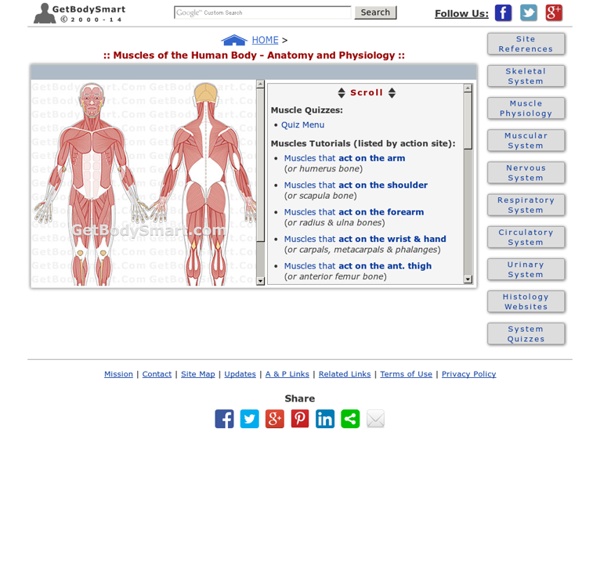



Anatomy and Physiology Learning Modules - CEHD - U of M Quiz Bowl and Timed Test were retired at the end of summer 2013. Quiz Bowl had always been buggy, as many people had pointed out, and it had become difficult to maintain. It also used technology that doesn’t work on a lot of newer computers or tablets. Timed test depended on a browser add-on that both Microsoft and Apple have encouraged users to remove for security concerns. For these reasons, we took these two quizzes down at the end of the month. Looking for the Image Bank? Conference for High School Anatomy and Physiology Instructors - October 17 and 18, 2014 - Minneapolis, MN. Digital Anatomist Interactive Atlases Structural Informatics GroupDepartment of Biological StructureUniversity of Washington Seattle, Washington, USA Atlases Content: 2-D and 3-D views of the brain from cadaver sections, MRI scans, and computer reconstructions.Author: John W. SundstenInstitution: Digital Anatomist Project, Dept. Content: Neuroanatomy Interactive Syllabus. Atlas was formerly available on CD-ROM (JAVA program running on Mac and PC platform). Content: 3-D views of thoracic organs reconstructed from 1 mm cryosections of a cadaver specimen provided by Wolfgang Rauschning.Authors: David M. Atlas was formerly available on CD-ROM. Content: 2-D and 3-D views of the knee from cadaver sections, MRI scans, and computer recontructions.Author: Peter Ratiu and Cornelius RosseInstitution: Digital Anatomist Project, Dept. FAQHelp on Program UseSoftware Credits and CopyrightPrivacy and advertising policiesAbout the Structural Informatics Group
Histology Tutor Background: A complex organism, such as a human, is made of collections of cells working together in performing a specific function. These groups of cells are called Tissues. The study of tissues is called Histology. Objectives: 1. Much of the information in this page is summarized in the following document: Dichotomous Key for Learning Basic Tissues. Section I -- Organs are made of many different tissues Section II -- The Four Basic Tissue Types Return to Top The 4 basic tissue types are Epithelium, Connective Tissue, Nervous Tissue, and Muscle. Section III -- Epithelium Return to Top A. The first step in finding epithelium on a slide is to look for free surfaces where epithelium may be present. The free surface is what faces the opening in the organ or tube (often these are called lumens) or what faces the outside as in skin. ** Below you can go to a short apical surface exercise using the Histology Zoomer. Click here to go to the Zoomer's Apical (free) surface Exercise B. C. D. E. F. A.
6 Virtual Tours Of The Human Body For Free Interactive Anatomy Lessons When it comes to interactive virtual views, we have gone to space and around the globe. So, it’s not surprising that we are also going within ourselves on a virtual journey of the human body. One of the finest tools available online is Visible Body. Unfortunately, it’s not free anymore. But you can see the beauty of it thanks to the free demo that allows you to explore the head and neck. If you are disappointed that there aren’t any free interactive anatomy tools, worry not. Google Body You can trust Google to take you everywhere. The Google Body browser is a Google Labs project that renders on Google Chrome and any other browser that supports WebGL (like Firefox 4 Beta). MEDtropolis The interactive website aims to educate entertain both kids and adult on bodily health; understanding the human anatomical structure is just part of the process. For instance, check out the narrated tours on Virtual Body. eSkeletons eSkeletons isn’t only about understanding human anatomy. DirectAnatomy
Brain Atlas - Introduction The central nervous system (CNS) consists of the brain and the spinal cord, immersed in the cerebrospinal fluid (CSF). Weighing about 3 pounds (1.4 kilograms), the brain consists of three main structures: the cerebrum, the cerebellum and the brainstem. Cerebrum - divided into two hemispheres (left and right), each consists of four lobes (frontal, parietal, occipital and temporal). The outer layer of the brain is known as the cerebral cortex or the ‘grey matter’. – closely packed neuron cell bodies form the grey matter of the brain. Cerebellum – responsible for psychomotor function, the cerebellum co-ordinates sensory input from the inner ear and the muscles to provide accurate control of position and movement. Brainstem – found at the base of the brain, it forms the link between the cerebral cortex, white matter and the spinal cord. Other important areas in the brain include the basal ganglia, thalamus, hypothalamus, ventricles, limbic system, and the reticular activating system. Neurons
Master Muscle List Home Page bodies-in-motion - scott-eaton.com 30 second sequences from BiM Not long ago, I had twelve artists from Natural Motion (of Morpheme and Clumsy Ninja fame) into Somerset House, my home away from home, for a four day anatomy workshop. At the end of each day we would take about 20 minutes to draw from the Bodies in Motion library. sketching from BiM We made extensive use of the timer for gesture drawing. timelapse of a sequence of 30 second poses Body proportions While there is significant variation in anatomical proportions between people, there are many references to body proportions that are intended to be canonical, either in art, measurement, or medicine. Similarly, in art, body proportions are the study of relation of human or animal body parts to each other and to the whole. These ratios are used in veristic depictions of the figure, and also become part of an aesthetic canon within a culture. Basics of human proportions[edit] Human proportions marked out in an illustration from a 20th century anatomy text-book. Different proportions in different people. It is important in figure drawing to draw the human figure in proportion. The proportions used in figure drawing are:[citation needed] Western ideal[edit] Leg-to-body ratio[edit] Another study using British and American participants, found "mid-ranging" leg-to-body ratios to be most ideal.[8] Muscle men and thin women[edit] Japanese ideal[edit] Leonardo da Vinci[edit] Additional images[edit]
All Stomach Muscles Anatomy And Abdominal Muscles Exercises